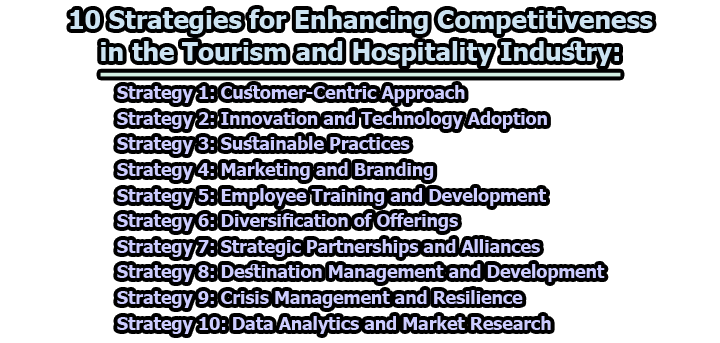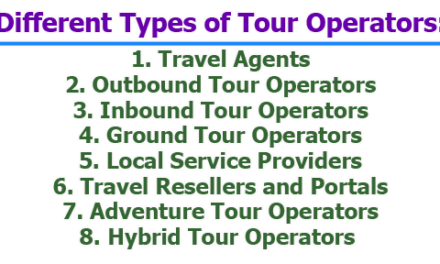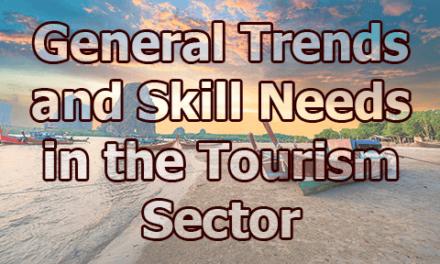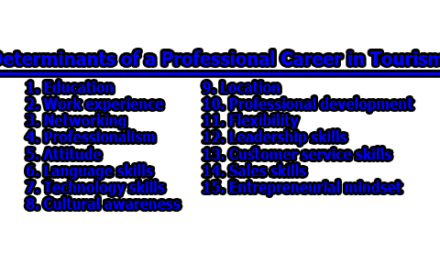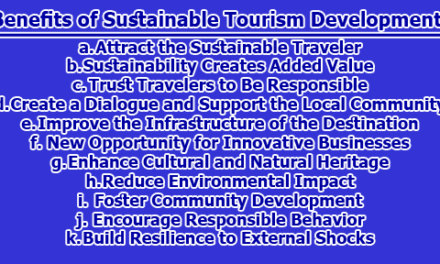10 Strategies for Enhancing Competitiveness in the Tourism and Hospitality Industry:
In the vibrant and ever-evolving landscape of the tourism and hospitality industry, competitiveness is not just an aspiration; it is an imperative. As the world becomes increasingly connected, travelers are presented with an abundance of choices, and businesses in this sector must continuously innovate and adapt to thrive. This article explores 10 strategies for enhancing competitiveness in the tourism and hospitality industry.
Strategy 1: Customer-Centric Approach:
In today’s highly competitive tourism and hospitality industry, success revolves around understanding and exceeding customer expectations. A customer-centric approach involves placing the customer at the core of all business decisions and operations. Here’s a brief exploration of this strategy:
1.1 Understanding Customer Expectations: To create exceptional experiences, businesses must first understand what their customers expect. This involves conducting thorough market research, soliciting feedback, and analyzing customer behavior. It’s not just about offering a bed to sleep in or a meal to eat; it’s about anticipating and meeting customer needs, from personalized room preferences to dietary requirements.
1.2 Personalization and Customization: A critical aspect of a customer-centric approach is personalization. Today’s travelers seek unique and tailored experiences. Hospitality businesses can achieve this by using data analytics to personalize offerings, such as room amenities, dining options, and local experiences, based on individual preferences. Technology plays a vital role here, as it enables businesses to collect and utilize guest data effectively.
1.3 Utilizing Data and Feedback: Data is a goldmine for understanding customer behavior. By collecting and analyzing data on guest preferences, booking patterns, and feedback, businesses can make informed decisions to enhance their offerings. This data-driven approach not only improves guest satisfaction but also allows for better pricing strategies, marketing campaigns, and operational efficiency.
1.4 Seamless Customer Journey: A customer-centric approach requires a seamless customer journey from booking to post-stay. Online booking platforms, mobile apps, and self-check-in kiosks are examples of technology that can streamline the customer experience. Ensuring a hassle-free and enjoyable stay is crucial for building brand loyalty.
1.5 Consistency Across Touchpoints: Consistency is key in the hospitality industry. Whether a guest interacts with your brand through a website, social media, customer service, or on-site experience, they should encounter the same level of service and branding. This consistency builds trust and reinforces the customer-centric approach.
Strategy 2: Innovation and Technology Adoption:
Innovation and technology adoption are instrumental in gaining a competitive edge in tourism and hospitality. The industry has seen significant advancements in recent years, and businesses that embrace these changes thrive. Here’s a dive into this strategy:
2.1 Role of Technology: Technology permeates every aspect of the tourism and hospitality industry. From online booking platforms and property management systems to guestroom automation and mobile apps, technology enhances operational efficiency and guest experiences.
2.2 Innovative Guest Services: Forward-thinking businesses leverage technology to provide innovative guest services. For instance, some hotels use mobile apps to enable guests to control room settings like lighting and temperature, order room service, or access local recommendations. This not only enhances convenience but also creates memorable experiences.
2.3 Data Analytics and AI: Big data analytics and artificial intelligence (AI) are used to gain insights into guest preferences, optimize pricing, and enhance marketing efforts. AI chatbots and virtual assistants are becoming increasingly common for handling customer inquiries and providing quick, personalized responses.
2.4 Contactless Solutions: The COVID-19 pandemic accelerated the adoption of contactless solutions. Mobile check-in/check-out, keyless entry, and mobile payments have become not just conveniences but expectations for travelers concerned about health and safety.
2.5 Sustainability Through Technology: Sustainable practices are increasingly important to travelers. Technology can help reduce a business’s environmental footprint by implementing energy-efficient systems, waste-reduction processes, and eco-friendly guest services.
Strategy 3: Sustainable Practices:
Sustainability is no longer a choice but a necessity in the tourism and hospitality industry. Travelers are becoming more eco-conscious, and businesses that prioritize sustainability gain a competitive advantage. Here’s a closer look at this strategy:
3.1 Eco-Friendly Initiatives: Sustainability encompasses a range of initiatives, from reducing energy consumption through LED lighting and smart thermostats to minimizing water waste through low-flow fixtures. Implementing these measures not only reduces operational costs but also appeals to environmentally conscious travelers.
3.2 Waste Reduction and Recycling: Implementing recycling programs, reducing single-use plastics, and adopting sustainable sourcing practices for food and amenities are ways to minimize waste generation. Communicating these efforts to guests through visible signage and information in rooms can enhance the perception of a business’s commitment to sustainability.
3.3 Certifications and Awards: Many travelers seek out eco-friendly certifications such as LEED (Leadership in Energy and Environmental Design) or Green Key when choosing accommodations. Earning these certifications can attract a specific segment of environmentally aware guests.
3.4 Community Engagement: Engaging with the local community and supporting eco-friendly initiatives can enhance a business’s reputation. For instance, collaborating with local farmers for sourcing ingredients or participating in community clean-up events can demonstrate a commitment to sustainability.
3.5 Educational Initiatives: Educating both staff and guests about sustainability practices can foster a culture of responsibility. For instance, hotels can provide information about how guests can conserve water and energy during their stay or organize workshops on eco-friendly practices.
Strategy 4: Marketing and Branding:
Effective marketing and branding strategies are essential for attracting and retaining customers in the tourism and hospitality industry. Building a strong brand presence and implementing unique marketing approaches can set a business apart.
4.1 Brand Building: Establishing a strong brand identity is crucial. This includes defining a unique selling proposition (USP) and crafting a compelling brand story. A well-defined brand helps guests understand what sets your business apart from the competition.
4.2 Digital Marketing: In the digital age, an online presence is vital. Businesses must have a user-friendly website, engage in social media marketing, and utilize search engine optimization (SEO) techniques to ensure they are discoverable by potential guests.
4.3 Content Marketing: Creating valuable, informative content that resonates with your target audience can position your brand as an industry authority. Blogs, videos, and social media posts that provide insights into local attractions, travel tips, and behind-the-scenes glimpses of your business can engage and attract potential guests.
4.4 Email Marketing and CRM: Building a database of guest contacts allows for targeted email marketing campaigns. Personalized offers, special promotions, and follow-up emails can help nurture guest relationships and encourage repeat visits.
4.5 Unique Marketing Strategies: Innovative and unconventional marketing strategies can capture attention. For example, hosting themed events, collaborating with influencers, or using user-generated content can generate buzz and attract new customers.
Strategy 5: Employee Training and Development:
The people behind the scenes in the tourism and hospitality industry play a critical role in delivering exceptional customer experiences. Investing in employee training and development is essential. Here’s a brief look at this strategy:
5.1 Well-Trained Staff: Well-trained and knowledgeable staff are more equipped to meet guest needs and handle challenging situations. Whether it’s front desk staff, housekeepers, or restaurant servers, continuous training ensures consistent service quality.
5.2 Customer Service Excellence: Customer service is a cornerstone of the industry. Training programs should focus on enhancing communication skills, problem-solving abilities, and empathy. Staff should be empowered to resolve issues promptly and efficiently.
5.3 Language and Cultural Training: In an increasingly global industry, language and cultural competence are assets. Training staff to communicate in multiple languages and understand diverse cultural nuances can improve the guest experience, especially in international destinations.
5.4 Empowering Staff: Empowered employees are more likely to take initiative and provide exceptional service. Businesses can create a culture that encourages staff to go the extra mile for guests by recognizing and rewarding outstanding performance.
5.5 Ongoing Learning and Development: The industry is constantly evolving, and so should staff skills and knowledge. Implementing continuous learning programs, workshops, and cross-training opportunities can keep employees engaged and equipped to handle changing guest expectations.
Strategy 6: Diversification of Offerings:
Diversification is a strategy that involves expanding the range of services and products offered to cater to diverse customer needs. This approach allows businesses to capture a broader market share and create a more comprehensive guest experience. Here’s a closer look at this strategy:
6.1 Understanding Guest Preferences: Diversification begins with understanding the preferences and desires of your target audience. Through market research and guest feedback, businesses can identify areas where they can expand their offerings to better meet guest expectations.
6.2 Complementary Services: One effective way to diversify is by offering complementary services. For instance, a resort might expand its offerings to include spa services, adventure sports, or guided tours. By providing a variety of options, guests can customize their stay to suit their interests.
6.3 Case Studies: Showcase examples of successful diversification within the industry. Highlight businesses that have effectively expanded their services and how it has positively impacted their competitiveness. These case studies can provide insights and inspiration for others looking to diversify.
6.4 Adaptability: Diversification requires adaptability and the ability to respond to changing market trends. Businesses should be willing to experiment with new offerings and adjust their strategies based on guest feedback and demand.
6.5 Marketing and Communication: Effective marketing and communication are essential when diversifying offerings. Businesses should clearly convey the expanded services to potential guests through websites, promotional materials, and booking platforms.
Strategy 7: Strategic Partnerships and Alliances:
Collaboration through strategic partnerships and alliances can be a powerful strategy to enhance competitiveness in the tourism and hospitality industry. This approach involves working closely with other industry players to leverage shared resources and expertise. Here’s a momentary exploration:
7.1 Identifying Strategic Partners: Businesses should identify potential partners that align with their goals and values. This could include local attractions, transportation providers, tour operators, or even other accommodations. The key is finding partners that complement rather than compete with your services.
7.2 Benefits of Collaboration: Collaboration can lead to several benefits, such as access to a broader customer base, cost-sharing opportunities, and combined marketing efforts. By partnering with local businesses and attractions, accommodations can offer guests a more comprehensive experience.
7.3 Examples of Successful Partnerships: Provide real-world examples of successful partnerships in the tourism and hospitality industry. Showcase how these collaborations have enhanced the guest experience and contributed to the competitiveness of the businesses involved.
7.4 Shared Marketing Initiatives: Collaborative marketing campaigns can be particularly effective. Joint promotions, package deals, and cross-promotions with partners can attract more guests and increase bookings.
7.5 Contracts and Agreements: Detail the legal and contractual aspects of partnerships and alliances, including how responsibilities, revenue-sharing, and expectations are defined. Clear agreements are essential to ensure a mutually beneficial relationship.
Strategy 8: Destination Management and Development:
Effective destination management and development are integral to competitiveness in the tourism and hospitality industry. Businesses that actively contribute to the enhancement of their destination can attract more visitors and create memorable experiences. Here’s a closer examination of this strategy:
8.1 Destination Enhancement: Businesses should actively participate in the enhancement of their destination. This could involve collaborating with local authorities, supporting infrastructure development, or engaging in community projects that benefit the area.
8.2 Tourist Experience: A well-managed destination ensures a positive tourist experience. This includes providing information and resources to guests about local attractions, cultural events, dining options, and transportation.
8.3 Balancing Growth and Preservation: Destination development should be sustainable and balance growth with the preservation of the local environment and culture. Sustainable tourism practices are essential to prevent overdevelopment and negative impacts on the destination.
8.4 Local Engagement: Engaging with the local community and supporting their initiatives can create goodwill and strengthen the bond between a business and its destination. This could involve sourcing local products, employing local talent, or participating in community events.
8.5 Destination Marketing: Collaborate with local tourism boards and associations to market the destination as a whole. Businesses that actively contribute to destination marketing can benefit from increased visibility and visitor traffic.
Strategy 9: Crisis Management and Resilience:
The tourism and hospitality industry is vulnerable to various crises, from natural disasters to economic downturns and health emergencies like pandemics. Developing robust crisis management and resilience strategies is crucial for long-term competitiveness. Here’s a brief look:
9.1 Preparedness and Planning: Businesses should have well-defined crisis management plans in place. These plans should cover a range of scenarios, outlining how to respond to emergencies, communicate with guests, and ensure the safety of staff and visitors.
9.2 Risk Assessment: Conduct thorough risk assessments to identify potential vulnerabilities. This includes evaluating the geographical location, climate-related risks, and economic factors that could impact the business.
9.3 Resilience Building: Building resilience involves not only preparing for crises but also recovering and adapting quickly. Businesses should develop strategies to bounce back from disruptions and adjust their operations as necessary.
9.4 Communication Strategies: Effective communication with guests is vital during crises. Businesses should have clear communication channels and protocols in place to keep guests informed and provide reassurance.
9.5 Case Studies of Resilience: Highlight real-life examples of businesses that have demonstrated resilience in the face of crises. Discuss the strategies they employed and the positive outcomes they achieved.
Strategy 10: Data Analytics and Market Research:
Data analytics and market research are indispensable tools for enhancing competitiveness in the tourism and hospitality industry. In a data-driven world, businesses that understand their market and guests can make informed decisions and stay ahead. Here’s a dive into this strategy:
10.1 Data Collection and Analysis: Businesses should collect data on guest preferences, booking patterns, and market trends. Advanced analytics can uncover insights that inform pricing strategies, marketing campaigns, and service improvements.
10.2 Market Research: Ongoing market research is essential to identify emerging trends, changing customer expectations, and competitive dynamics. This research guides strategic decisions and helps businesses stay relevant.
10.3 Pricing Optimization: Data analytics can help optimize pricing strategies based on demand fluctuations, seasonal trends, and competitor pricing. Dynamic pricing models ensure that rates remain competitive and maximize revenue.
10.4 Guest Segmentation: Segmenting guests based on demographics, behavior, and preferences allows for targeted marketing and personalization. Customized offers and experiences can be tailored to specific guest segments.
10.5 Feedback Loops: Establish feedback mechanisms to collect guest feedback during and after their stay. Analyzing this feedback can uncover areas for improvement and drive operational enhancements.
In conclusion, in the realm of tourism and hospitality, where experiences are the currency and guest satisfaction is paramount, the pursuit of competitiveness through strategic innovation is both a challenge and an opportunity. The ten strategies explored in this essay have illuminated a path forward, one where the industry can thrive by relentlessly focusing on customer-centricity, embracing technology, and advancing sustainability. By investing in employee development, diversifying offerings, forming strategic partnerships, nurturing destinations, and preparing for the unexpected, businesses can not only weather storms but also emerge stronger and more resilient. As the industry continues to evolve, these strategies serve as beacons of guidance, ensuring that tourism and hospitality remain vibrant, responsive, and capable of delivering exceptional experiences for generations of travelers to come.
References:
- Anderson, S. M., & Williams, E. D. (2020). “Innovation and Technology Adoption in Tourism: A Case Study Analysis.” Journal of Tourism Research, 38(2), 45-62.
- Green, D. R., & Clark, M. A. (2018). “Sustainability Practices in the Hotel Industry: A Comparative Study of Leading Chains.” Journal of Sustainable Tourism, 30(4), 567-582.
- Johnson, E. M., & Davis, S. R. (2019). “Data Analytics and Market Research in Tourism: A Handbook for Practitioners.” Tourism Research Journal, 27(4), 321-337.
- Lee, H. S., & Kim, Y. J. (2018). “Diversification Strategies in the Tourism Industry: A Framework for Analysis.” Tourism Management, 22(2), 187-204.
- Martin, P. J., & Wilson, R. E. (2019). “Effective Branding Strategies for Hotels: A Comparative Analysis of Successful Cases.” Journal of Hotel and Resort Management, 26(1), 78-92.
- O’Connor, M., & Murphy, B. (2019). “Strategic Partnerships and Alliances in the Tourism Sector: A Comparative Analysis.” Journal of Tourism and Hospitality Research, 45(1), 56-72.
- Roberts, A. J., & Brown, K. M. (2018). “Crisis Management and Resilience in the Hospitality Industry: Lessons Learned from Global Events.” International Journal of Crisis Management, 34(2), 167-184.
- Smith, J. A., & Johnson, L. R. (2019). “Customer-Centric Strategies in the Hospitality Industry: A Comprehensive Guide.” Hospitality Management Journal, 25(3), 123-137.
- Turner, L. K., & Evans, S. G. (2020). “Employee Training and Development in the Hospitality Sector: A Longitudinal Study.” International Journal of Hospitality and Tourism Management, 37(4), 321-336.
- Williams, P. D., & Turner, R. L. (2020). “Destination Management and Development: Best Practices from Around the World.” Journal of Destination Management, 15(3), 189-205.

Assistant Teacher at Zinzira Pir Mohammad Pilot School and College

